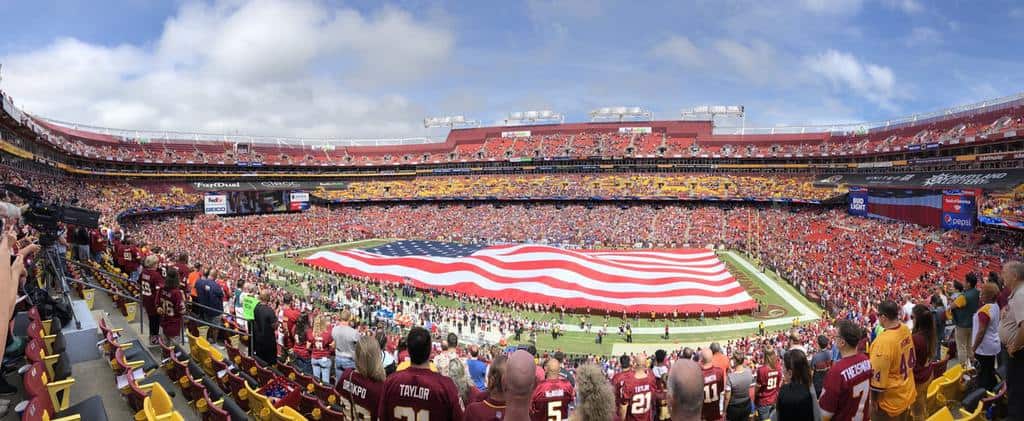For most people, sport is a lifelong passion with an affiliation to a particular team passed down from generation to generation. When game day comes around, all they care about is that their team wins. For many fans the quality of the game is less important than the victorious result, which highlights some of the economic differences between European soccer and American football.
For most of the history of sport, most people involved, including the players and management were only involved because of their love for the game. In English soccer, players were not allowed to receive financial compensation for their efforts in the early years of the sport.
Nowadays, though, success requires money. Sport has become a big business; several NFL teams are valued at more than $1 billion, as are a handful of English Premier League teams. Both also have many teams with annual revenues in the hundreds of millions.
2 Main Economic Differences Between Soccer and Football
TV Revenue
On both sides of the pond, football (American football) and soccer (association football) attract huge sums of money from TV broadcasters. They spend this money to buy the rights to broadcast games to fans.
These TV networks then recoup these huge sums by selling adverts during games and by charging subscription fees. In the UK, the main satellite TV broadcaster, Sky, built its business by being the sole rights holder to live Premier League games.
This TV rights money is the largest source of income for both the Premier League and the NFL.
Different Models
Despite these similarities, sports leagues in Europe are typically run very differently from those in the United States. In economic theory, American sports teams are profit-maximizing—meaning that their primary objective is to accumulate as much profit as possible—while in Europe, they are utility-maximizing, meaning that they place their focus on sporting success.
The Premier League

Using English soccer as an example (although most of European soccer operates in the same way), teams can be promoted and relegated through a pyramid of leagues, with the Premier League sitting at the top.
In theory, this means that an English team can win its way up from the lower leagues into the Premier League. In practice, this is not so much the case, with teams typically remaining static or moving up and down between just 2/3 leagues over several decades.
To succeed in English soccer, a team must be managed to prioritize sporting success. Examples of team owners who have tried to run a “fiscally sound” team include businessman Alan Sugar, who bought Tottenham Hotspur in 1991. His management of the team angered fans, which saw him appoint and sack seven managers and resulted in just a single trophy in nine years. He later described his time at the club as “a waste of (his) life”.
Browse more popular posts from Complete Soccer Guide:
- Coronavirus and its effect on the Soccer World
- The Biggest and Best Soccer Tournaments
- Soccer Players to Watch to Improve your Game
The NFL
The NFL is a closed league. In contrast to English soccer, teams in the NFL remain in the NFL regardless of their performance. This means that a team can lose all of its games in one year and then theoretically win the Super Bowl the following year. This is another economic difference between European soccer and American football.
Like most American leagues, the NFL is split into a regular season and a playoff tournament. This means that not all teams will play each other and that poor performance early in the season can be offset by success later on. It protects the financial position of teams who have a bad year, whereas relegation from the Premier League means a huge drop in revenue.
This format also means that the winner of the league is decided by a single game. In contrast, in the 2018/19 Premier League, both Liverpool and Manchester City could have won the league on the final day of the season, but the outcome depended on City’s game with Brighton.
The final game in the NFL playoffs is the Super Bowl—the biggest game in American football and American sport in general. The single game attracts around 100 million viewers from across the country, and even more when you include the rest of the world. It is watched by the fans of the two teams involved, other football fans, and non-football fans alike—all three of them enjoying the pageantry and traditions that go along with the game.
This huge audience means that the Super Bowl is very attractive for businesses. Many pay millions of dollars to sponsor the game or have their advertisements shown during the TV coverage. Bookmakers also run promotions in the lead up to the game, including free bets for regular customers and offering them expert analyses from their sports team.
This format is a massive commercial boon to the NFL and its teams, as it means that fans can focus all of their attention on a single game that decides the league’s winner.
Although the two sides of the Atlantic have different approaches to their sports leagues, it is clear that both work well for them; the NFL is one of the wealthiest sports leagues in the world, while the Premier League is one of the best soccer competitions.
In Europe, sporting success must come before financial success, with winning trophies resulting in large increases in revenue, while teams in America are protected from financial ruin if they have a bad year.
Both systems create a disparity between the richest and poorest teams, and both generate their income from the same sources. Yet, both sides must manage their money differently to achieve long-term success.

